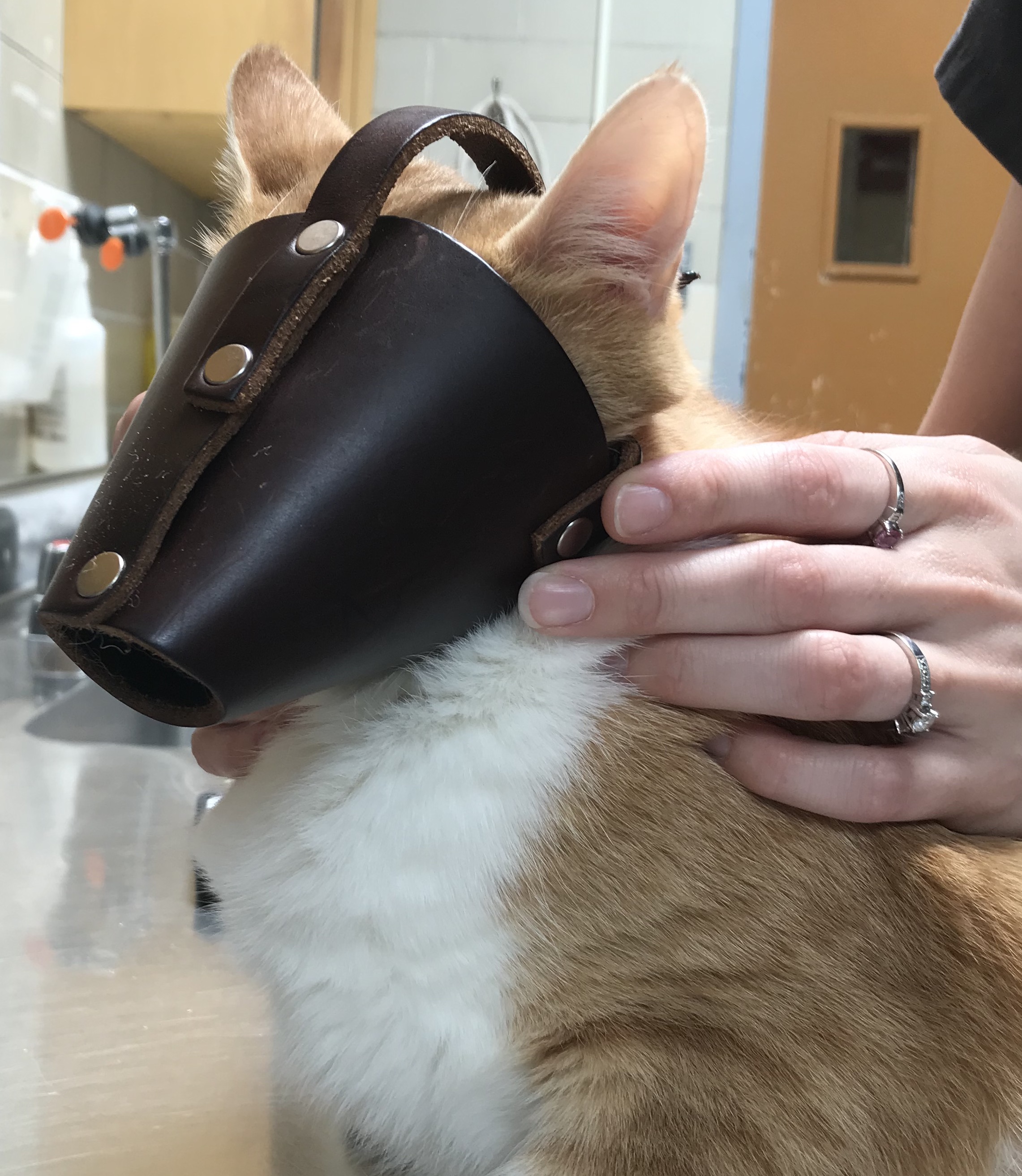Feline Restraint and Handling
Feline Restraint Techniques
Introduction
Stuffed cats are used for laboratory demonstration purposes to help you understand handling and restraint techniques. The laboratory activities build upon lecture material that Dr. Niel presented in this course.
Thank you to Andrew the cat for starring in many of the videos for this module.
Learning Objectives
- Practice performing a ring hold on a stuffed cat
- Practice performing a three-finger hold on a stuffed cat
- Practice performing at least one towel wrap on a stuffed cat
- Understand how to place a muzzle on a cat
Feline Restraint Techniques:
Minimal restraint techniques: Some cats will be amenable to minimal restraint. It’s important to not use the maximum restraint with all cats from the start of the procedures. Cats often benefit from minimal restraint techniques. Over-restraint can cause the cat to feel threatened, leading to escape attempts. Cats also do not like it when people stand over them.
Try to allow the cat to maintain her own position (e.g., sitting, lateral recumbency) and work around her. Adjust your position so that you are seated beside or behind the cat. Cats that are “lap cats” at home might allow you to examine them while on your lap. Be creative and work with the cat. If the cat is struggling for more than a few seconds, allow a rest and try a new technique.
Feline Restraint: Specific Techniques
Ring Grip
- Cats amendable to minimal restraint can be held using a “ring-grip” just below the chin, with your body behind the cat to prevent him from backing up. Ensure that your ring-grip is not a closed circle around the neck; it is essential that you do not apply pressure especially to the trachea. Head scratches during this restraint are appreciated.
- This restraint will allow a second person can access the jugular vein, or other regions in the front of the cat.
- The first video demonstrates hand position using a stuffed cat, to allow a slower motion in the demonstration:
- The second video shows the use of this restraint on a live cat:
Three-finger hold
- This can be used as an alternative to scruffing. The entire hand is used in the restraint, positioned so that three fingers remain on the top of the cat’s head as demonstrated in the following video (first showing the positioning in a stuffed cat using slower motion, then application of the technique in the clinic):
A Note on “Scruffing”
“Scruffing” refers to a person firmly grasping the skin/subcutaneous tissue of the dorsal cervical region. It is likened to a similar technique that the mother cat uses to carry kittens. The above techniques are recommended instead of scruffing cats.
Some veterinary behaviour specialists disagree with this being used as a restraint technique; other veterinarians find it a safe and effective technique to use in handling animals that need more restraint. If you do use scruffing as a form of restraint, avoid lifting or picking up a cat by the scruff as this can cause pain. Avoid applying the scruffing technique to all cat handling experiences (i.e., if you choose to use this as part of your restraint, try to use it sparingly).
Towel wraps
Some cats like to be swaddled in a towel, so this technique is not restricted to fractious cats. The towel may make the cat feel more secure. There are many variations of towel wraps that can be performed on cats.
Choose towels that are large enough to fully cover the cat. Note that towels reduce the chances of a bite or scratch, but use does not fully prevent these risks. Several types of towel wraps can be performed, some examples are below:
The half-burrito wrap, leaving cat’s head and neck exposed (e.g., examination of the head, jugular venipuncture access):
The scarf wrap, leaving the cat’s front and hind end accessible but also allowing the handler to decrease movement of the cat without applying a scruff. This technique is also effective in small dogs.
* Do these techniques work on fractious cats? See the videos in the following link: *
Other Tools in Feline Restraint
Cat muzzles: A muzzle applied to a cat has several advantages:
-
- Less likely to get bitten during restraint when placed properly
- Distracts the cat
- Cat cannot see / hiding sensation

Protective gloves: Heavy leather gloves (that extend to cover the forearm) can be used by a restrainer to avoid being bitten, scratched when handling fractious animals.
Sedation: Some cats will require chemical restraint (i.e., sedation) to make handling safe for both the cat and the veterinary team. Intramuscular (IM) or SC injections of sedative agents require the least amount of patient handling prior to sedation (versus oral or IV administration).

